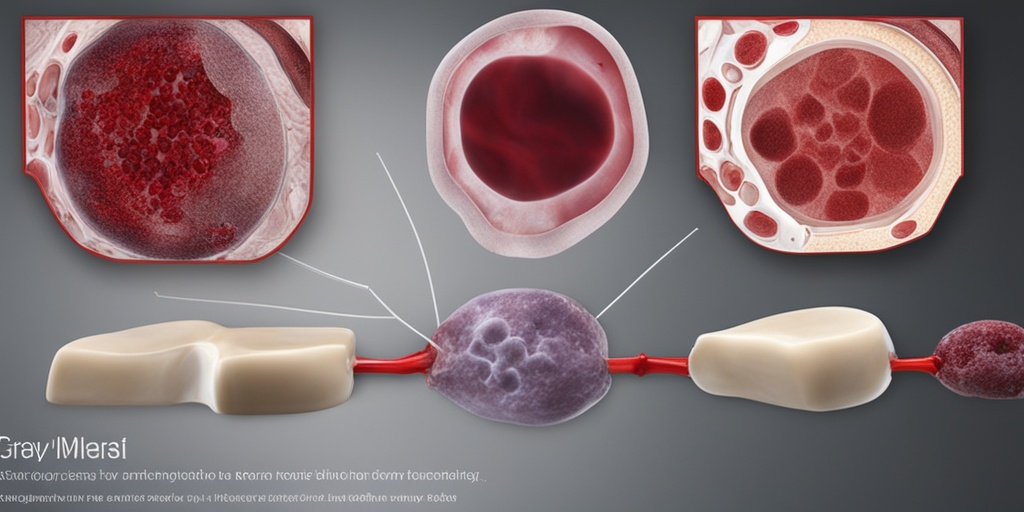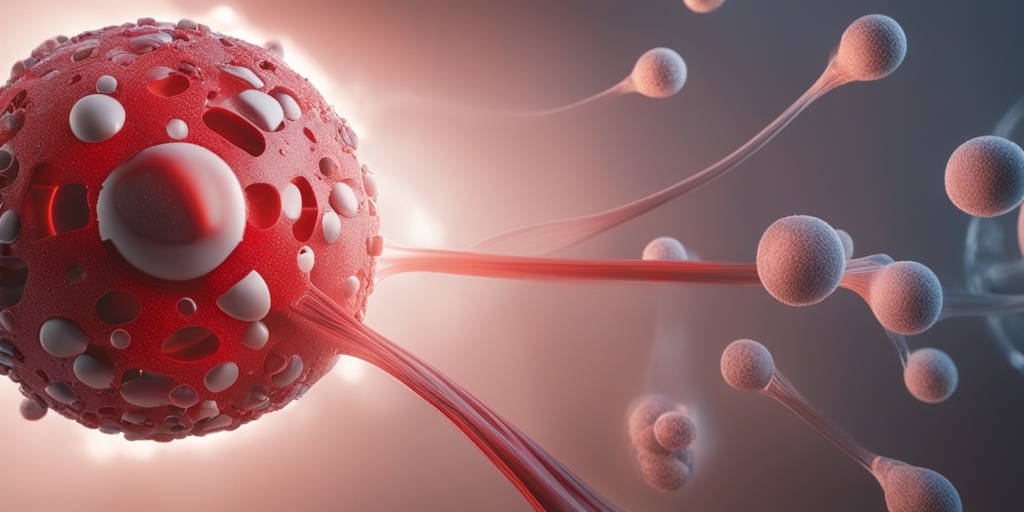What Is Idiopathic Aplastic Anemia?
Have you or a loved one been diagnosed with idiopathic aplastic anemia? If so, you’re likely wondering what this condition is and how it affects the body. In this article, we’ll delve into the world of idiopathic aplastic anemia, exploring its definition, symptoms, diagnosis, and treatment options.
Defining Idiopathic Aplastic Anemia
Idiopathic aplastic anemia is a rare and serious blood disorder characterized by the failure of the bone marrow to produce enough new blood cells. This results in a shortage of red blood cells, white blood cells, and platelets in the blood.
In a healthy individual, the bone marrow produces stem cells that mature into different types of blood cells. However, in people with idiopathic aplastic anemia, the bone marrow fails to produce these stem cells, leading to a deficiency of essential blood components.
What Does “Idiopathic” Mean?
The term “idiopathic” means that the cause of the condition is unknown. In other words, doctors cannot pinpoint a specific reason why the bone marrow is not producing enough blood cells. This is in contrast to acquired aplastic anemia, which is caused by exposure to certain toxins, radiation, or chemotherapy.
Understanding Aplastic Anemia
Aplastic anemia is a broader term that encompasses both idiopathic and acquired forms of the condition. To better understand aplastic anemia, let’s break it down into its key components:
The Role of Bone Marrow
Bone marrow is the spongy tissue inside our bones responsible for producing blood cells. It’s a vital function that ensures our body has a steady supply of oxygen-carrying red blood cells, infection-fighting white blood cells, and clot-forming platelets.
The Consequences of Aplastic Anemia
When the bone marrow fails to produce enough blood cells, the body is left vulnerable to a range of complications. These may include:
- Anemia (low red blood cell count)
- Infections (low white blood cell count)
- Bleeding or bruising (low platelet count)
- Fatigue, weakness, and shortness of breath
It’s essential to seek medical attention if you’re experiencing any of these symptoms, as aplastic anemia can be life-threatening if left untreated.
Stay tuned for our next article, where we’ll explore the diagnosis, treatment, and management of idiopathic aplastic anemia. In the meantime, if you have any questions or concerns about this condition, consider reaching out to a trusted health resource like Yesil Health AI for evidence-based answers.
👍

Idiopathic Aplastic Anemia Symptoms
Idiopathic aplastic anemia (IAA) is a rare and serious blood disorder that affects the bone marrow’s ability to produce blood cells. As a result, people with IAA often experience a range of symptoms that can be mild, moderate, or severe. In this section, we’ll delve into the common symptoms of idiopathic aplastic anemia and what you can expect if you or a loved one has been diagnosed with this condition.
Fatigue and Weakness
One of the most common symptoms of idiopathic aplastic anemia is fatigue and weakness. This is because the body is not producing enough red blood cells, which are responsible for carrying oxygen to the body’s tissues. As a result, people with IAA may feel tired, weak, and lacking in energy, even after resting.
Bleeding and Bruising
Another common symptom of idiopathic aplastic anemia is bleeding and bruising. This is because the body is not producing enough platelets, which are responsible for blood clotting. People with IAA may experience easy bruising, nosebleeds, or bleeding gums, and may be more prone to bleeding during surgery or injury.
Infections
Idiopathic aplastic anemia can also increase the risk of infections. This is because the body is not producing enough white blood cells, which are responsible for fighting off infections. People with IAA may experience frequent or recurring infections, such as pneumonia, sinus infections, or skin infections.
Shortness of Breath
Shortness of breath is another common symptom of idiopathic aplastic anemia. This is because the body is not producing enough red blood cells, which can lead to a lack of oxygen in the body’s tissues. People with IAA may experience shortness of breath even when doing simple tasks, such as walking or climbing stairs.
Pale Skin
People with idiopathic aplastic anemia may also experience pale skin, which is a result of the body’s lack of red blood cells. This can be a visible sign of the condition and may be more noticeable in people with fair skin.
Other Symptoms
In addition to these common symptoms, people with idiopathic aplastic anemia may also experience:
- Dizziness or lightheadedness
- Headaches
- Palpitations or rapid heartbeat
- Swollen lymph nodes
- Fever
It’s essential to remember that these symptoms can be mild, moderate, or severe, and may vary from person to person. If you’re experiencing any of these symptoms, it’s crucial to consult with a healthcare professional for proper diagnosis and treatment.
Causes of Idiopathic Aplastic Anemia
Idiopathic aplastic anemia is a complex condition, and its exact causes are still not fully understood. However, research suggests that it may be related to a combination of genetic and environmental factors. In this section, we’ll explore the possible causes of idiopathic aplastic anemia and what may trigger this condition.
Genetic Mutations
Some people may be born with genetic mutations that increase their risk of developing idiopathic aplastic anemia. These mutations can affect the genes responsible for blood cell production, leading to a malfunction in the bone marrow.
Environmental Toxins
Exposure to environmental toxins, such as pesticides, heavy metals, or industrial chemicals, may also contribute to the development of idiopathic aplastic anemia. These toxins can damage the bone marrow and disrupt blood cell production.
Autoimmune Disorders
In some cases, idiopathic aplastic anemia may be triggered by autoimmune disorders, such as rheumatoid arthritis or lupus. In these cases, the immune system mistakenly attacks the bone marrow, leading to a decrease in blood cell production.
Viral Infections
Viral infections, such as hepatitis or Epstein-Barr virus, may also trigger idiopathic aplastic anemia in some people. These infections can damage the bone marrow and disrupt blood cell production.
Other Possible Causes
In addition to these possible causes, idiopathic aplastic anemia may also be triggered by:
- Certain medications, such as chemotherapy drugs
- Radiation therapy
- Pregnancy
- Certain medical conditions, such as paroxysmal nocturnal hemoglobinuria
It’s essential to remember that idiopathic aplastic anemia is a rare condition, and most people who are exposed to these factors will not develop the condition. However, if you’re experiencing any symptoms or have concerns, it’s crucial to consult with a healthcare professional for proper diagnosis and treatment.

Risk Factors for Developing Idiopathic Aplastic Anemia
Idiopathic aplastic anemia is a rare and complex blood disorder that can affect anyone, regardless of age or gender. While the exact causes of idiopathic aplastic anemia are still unknown, researchers have identified certain risk factors that may increase an individual’s likelihood of developing the condition.
Genetic Predisposition
Studies have shown that people with a family history of idiopathic aplastic anemia or other blood disorders are more likely to develop the condition. This suggests that there may be a genetic component to the disease, although the exact mechanisms are not yet fully understood.
Environmental Toxins
Exposure to certain environmental toxins, such as pesticides, heavy metals, and industrial chemicals, has been linked to an increased risk of developing idiopathic aplastic anemia. These toxins can damage the bone marrow, leading to a decrease in blood cell production.
Previous Chemotherapy or Radiation Therapy
People who have undergone chemotherapy or radiation therapy for cancer treatment are at a higher risk of developing idiopathic aplastic anemia. This is because these treatments can damage the bone marrow, leading to a decrease in blood cell production.
Autoimmune Disorders
Individuals with autoimmune disorders, such as rheumatoid arthritis or lupus, are more likely to develop idiopathic aplastic anemia. This is because autoimmune disorders can cause the immune system to attack healthy cells, including those in the bone marrow.
Other Risk Factors
Other risk factors for developing idiopathic aplastic anemia include:
- Age: Idiopathic aplastic anemia can affect people of all ages, but it is more common in older adults.
- Gender: Men are more likely to develop idiopathic aplastic anemia than women.
- Ethnicity: Idiopathic aplastic anemia is more common in people of Asian and Hispanic descent.
Diagnosing Idiopathic Aplastic Anemia
Diagnosing idiopathic aplastic anemia can be a complex and challenging process, as the symptoms can be similar to those of other blood disorders. A diagnosis is typically made through a combination of physical examination, medical history, and laboratory tests.
Physical Examination
A physical examination may reveal signs of anemia, such as pale skin, fatigue, and shortness of breath. The doctor may also check for signs of bleeding, such as bruising or petechiae (small red or purple spots on the skin).
Medical History
A thorough medical history is essential in diagnosing idiopathic aplastic anemia. The doctor will ask about the patient’s symptoms, medical history, and any previous illnesses or treatments.
Laboratory Tests
Laboratory tests are used to confirm the diagnosis of idiopathic aplastic anemia. These tests may include:
- Complete Blood Count (CBC): A CBC measures the different components of blood, including red blood cells, white blood cells, and platelets.
- Bone Marrow Biopsy: A bone marrow biopsy involves removing a sample of bone marrow tissue for examination under a microscope.
- Peripheral Blood Smear: A peripheral blood smear involves examining a sample of blood under a microscope to look for abnormal cells.
A diagnosis of idiopathic aplastic anemia is typically made when the bone marrow biopsy shows a decrease in blood cell production, and other potential causes of anemia have been ruled out. 💉

Treatment Options for Idiopathic Aplastic Anemia
When it comes to treating idiopathic aplastic anemia, the goal is to increase the production of blood cells and manage symptoms. The treatment approach often depends on the severity of the condition, age, and overall health of the individual. Here are some of the common treatment options for idiopathic aplastic anemia:
Supportive Care
Supportive care is usually the first line of treatment for idiopathic aplastic anemia. This approach focuses on managing symptoms, preventing complications, and improving the quality of life. Supportive care may include:
- Transfusions of red blood cells, platelets, and white blood cells to replace missing or low blood cell counts
- Antibiotics to prevent and treat infections
- Pain management medications to alleviate symptoms like fatigue and bone pain
- Medications to stimulate the production of blood cells, such as erythropoietin (EPO) and granulocyte-colony stimulating factor (G-CSF)
Immunosuppressive Therapy
Immunosuppressive therapy is often used to treat idiopathic aplastic anemia by suppressing the immune system’s attack on the bone marrow. This approach may include:
- Antithymocyte globulin (ATG) to reduce the immune system’s activity
- Cyclosporine to suppress the immune system and promote blood cell production
- Corticosteroids to reduce inflammation and promote blood cell production
Bone Marrow Transplantation
Bone marrow transplantation is a more aggressive treatment option for idiopathic aplastic anemia. This approach involves replacing the damaged bone marrow with healthy stem cells from a donor. Bone marrow transplantation can be an effective treatment option for severe cases of idiopathic aplastic anemia, especially in younger patients.
Experimental Treatments
Researchers are continuously exploring new and innovative treatment options for idiopathic aplastic anemia. Some experimental treatments include:
- Eltrombopag, a medication that stimulates the production of platelets
- Androgens, such as oxymetholone, to stimulate the production of red blood cells
- Stem cell therapies, such as mesenchymal stem cells, to promote blood cell production
Managing Idiopathic Aplastic Anemia Complications
Idiopathic aplastic anemia can lead to various complications, including infections, bleeding, and organ damage. Managing these complications is crucial to prevent further health problems. Here are some ways to manage idiopathic aplastic anemia complications:
Infection Prevention and Management
Infections are a common complication of idiopathic aplastic anemia. To prevent and manage infections, it’s essential to:
- Practice good hygiene, such as washing hands regularly
- Avoid close contact with people who are sick
- Get vaccinated against common infections, such as pneumonia and influenza
- Take antibiotics as prescribed by your doctor
Bleeding Prevention and Management
Bleeding is another common complication of idiopathic aplastic anemia. To prevent and manage bleeding, it’s essential to:
- Avoid activities that may cause injury or trauma
- Take medications to promote blood clotting, such as platelet transfusions
- Apply pressure to bleeding wounds to stop the bleeding
Organ Damage Prevention and Management
Idiopathic aplastic anemia can lead to organ damage, especially to the heart, lungs, and liver. To prevent and manage organ damage, it’s essential to:
- Get regular check-ups and monitoring to detect any organ damage early
- Take medications to manage symptoms and prevent further damage
- Make lifestyle changes, such as quitting smoking and reducing alcohol consumption, to reduce the risk of organ damage
By understanding the treatment options and managing complications, individuals with idiopathic aplastic anemia can improve their quality of life and reduce the risk of further health problems. 💊

Frequently Asked Questions about Idiopathic Aplastic Anemia
What is Idiopathic Aplastic Anemia?
Idiopathic Aplastic Anemia is a rare blood disorder where the bone marrow fails to produce enough new blood cells, including red blood cells, white blood cells, and platelets. This can lead to fatigue, weakness, and increased risk of infections and bleeding.
What are the symptoms of Idiopathic Aplastic Anemia?
The symptoms of Idiopathic Aplastic Anemia can vary from person to person, but common symptoms include:
- Fatigue and weakness
- Shortness of breath
- Pale skin
- Easy bruising and bleeding
- Frequent infections
- Enlarged spleen
How is Idiopathic Aplastic Anemia diagnosed?
Diagnosis of Idiopathic Aplastic Anemia typically involves a combination of:
- Medical history and physical examination
- Complete Blood Count (CBC) to check for low blood cell counts
- Bone marrow biopsy to examine bone marrow cells
- Imaging tests, such as X-rays or CT scans, to rule out other conditions
What are the treatment options for Idiopathic Aplastic Anemia?
Treatment for Idiopathic Aplastic Anemia usually involves:
- Medications to stimulate blood cell production
- Blood transfusions to replace missing blood cells
- Immunosuppressive therapy to suppress the immune system
- Bone marrow transplantation in severe cases
What is the life expectancy of someone with Idiopathic Aplastic Anemia?
The life expectancy of someone with Idiopathic Aplastic Anemia varies depending on the severity of the condition and the effectiveness of treatment. With proper treatment, many people with Idiopathic Aplastic Anemia can lead normal or near-normal lives.
Can Idiopathic Aplastic Anemia be inherited?
Idiopathic Aplastic Anemia is not directly inherited, but some genetic mutations can increase the risk of developing the condition.
Is Idiopathic Aplastic Anemia the same as Aplastic Anemia in dogs?
No, Idiopathic Aplastic Anemia is a human condition, while Aplastic Anemia in dogs is a similar condition that affects canines. While the symptoms and treatment options may be similar, they are distinct conditions.
What is the ICD-10 code for Idiopathic Aplastic Anemia?
The ICD-10 code for Idiopathic Aplastic Anemia is D61.9.
How common is Idiopathic Aplastic Anemia?
Idiopathic Aplastic Anemia is a rare condition, affecting approximately 2-5 people per million per year in the United States.
What is the pathophysiology of Idiopathic Aplastic Anemia?
The pathophysiology of Idiopathic Aplastic Anemia involves the failure of bone marrow stem cells to produce new blood cells, leading to a deficiency of red blood cells, white blood cells, and platelets.
Can Idiopathic Aplastic Anemia be cured?
In some cases, Idiopathic Aplastic Anemia can be cured with bone marrow transplantation or immunosuppressive therapy. However, for many people, the condition can be managed with ongoing treatment, but not cured.
I hope this FAQ helps! 🤞




